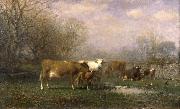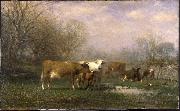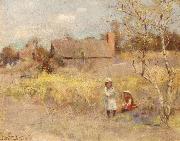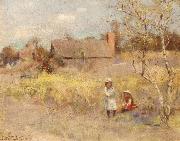
|
James McDougal Hart
|
|||
|
|
|||
| (May 10, 1828 - October 24, 1901), was a Scottish-born American landscape and cattle painter of the Hudson River School. His older brother, William Hart, was also a Hudson River School artist, and the two painted similar subjects. Hart was born in Kilmarnock, Scotland, and was taken to America with his family in early youth. In Albany, New York he trained with a sign and carriage maker possibly the same employer that had taken on his brother in his early career. Unlike his brother, however, James returned to Europe for serious artistic training. He studied in Munich, and was a pupil of Friedrich Wilhelm Schirmer in Dusseldorf. Hart returned to America in 1853. He exhibited his first work at the National Academy of Design in 1848, became an associate in 1857 and a full member in 1859. James Hart was particularly devoted to the National Academy, exhibiting there over a period of more than forty years, and serving as vice president late in his life from 1895 to 1899. Like his brother, James also exhibited at the Brooklyn Art Association (he lived for a time in Brooklyn) and at major exhibitions around the country. Along with most of the major landscape artists of the time, Hart based his operations in New York City and adopted the style of the Hudson River School. While James Hart and his brother William often painted similar landscape subjects, James may have been more inclined to paint exceptionally large works. An example is The Old Homestead (1862), 42 x 68 inches, in the collection of the High Museum of Art in Atlanta, Georgia. James may have been exposed to large paintings while studying in D??sseldorf, a center of realist art pedagogy that also shaped the practices of Albert Bierstadt and Worthington Whittredge. William Hart, who did not seek academic European training, seems to have been more comfortable painting small and mid-sized works. Like his brother William, James excelled at painting cattle. Kevin J. Avery writes, "the bovine subjects that once distinguished [his works] now seem the embodiment of Hart's artistic complacency." In contrast with the complacency of some of his cattle scenes, his major landscape paintings are considered important works of the Hudson River School. | |||
|
|
|||
|
Midsummer new23/James McDougal Hart-569843.jpg Painting ID:: 71381 |
ca. 1870(1870) Oil on canvas 55.9 x 91.4 cm (22.01 x 35.98 in) | ||
|
|
|||
|
James McDougal Hart
|
|||
|
|
|||
| (May 10, 1828 - October 24, 1901), was a Scottish-born American landscape and cattle painter of the Hudson River School. His older brother, William Hart, was also a Hudson River School artist, and the two painted similar subjects. Hart was born in Kilmarnock, Scotland, and was taken to America with his family in early youth. In Albany, New York he trained with a sign and carriage maker possibly the same employer that had taken on his brother in his early career. Unlike his brother, however, James returned to Europe for serious artistic training. He studied in Munich, and was a pupil of Friedrich Wilhelm Schirmer in Dusseldorf. Hart returned to America in 1853. He exhibited his first work at the National Academy of Design in 1848, became an associate in 1857 and a full member in 1859. James Hart was particularly devoted to the National Academy, exhibiting there over a period of more than forty years, and serving as vice president late in his life from 1895 to 1899. Like his brother, James also exhibited at the Brooklyn Art Association (he lived for a time in Brooklyn) and at major exhibitions around the country. Along with most of the major landscape artists of the time, Hart based his operations in New York City and adopted the style of the Hudson River School. While James Hart and his brother William often painted similar landscape subjects, James may have been more inclined to paint exceptionally large works. An example is The Old Homestead (1862), 42 x 68 inches, in the collection of the High Museum of Art in Atlanta, Georgia. James may have been exposed to large paintings while studying in D??sseldorf, a center of realist art pedagogy that also shaped the practices of Albert Bierstadt and Worthington Whittredge. William Hart, who did not seek academic European training, seems to have been more comfortable painting small and mid-sized works. Like his brother William, James excelled at painting cattle. Kevin J. Avery writes, "the bovine subjects that once distinguished [his works] now seem the embodiment of Hart's artistic complacency." In contrast with the complacency of some of his cattle scenes, his major landscape paintings are considered important works of the Hudson River School. | |||
|
|
|||
|
Midsummer new23/James McDougal Hart-688848.jpg Painting ID:: 72481 |
Date ca. 1870(1870) Medium Oil on canvas Dimensions 55.9 X 91.4 cm (22.01 X 35.98 in) cyf | ||
|
|
|||
|
Walter Withers
|
|||
|
|
|||
| English-born Australian Painter, 1854-1914 was an Australian landscape artist and a member of the Heidelberg School of Australian impressionists. Withers was born at Handsworth, Staffordshire, the son of Edwin Withers. He showed an early desire to paint, but objection was made to this by his father. It is not known what occupation he followed in England, but in 1882 he arrived in Australia with the intention of going on the land. After working for about 18 months on a farm, Withers removed to Melbourne and obtained a position as draughtsman in a firm of printers. He then took up his painting again, and began to exhibit with the Victorian Academy of Arts afterwards merged in the Victorian Artists' Society. In 1887 Withers went to Europe. There he was married to Miss F. Flinn and studied for some months at the Academie Julian, Paris. He returned to Australia with his wife in June 1888 having been commissioned to do black and white work for Messrs Fergusson and Mitchell of Melbourne. His most important work in this way will be found in the illustrations to Edmund Finn's, The Chronicles of Early Melbourne. Withers settled down at first at Kew, a suburb of Melbourne, and then near Heidelberg on the other side of the river Yarra. He became friendly with Arthur Streeton, Charles Conder, Tom Roberts, Frederick McCubbin and other leading artists of the period. He began to sell a few pictures, but the collapse of the land boom put an end to his illustrative work. He obtained some work as a drawing and painting master in schools, and in 1891 opened a studio in Collins-street west, where he held his first private exhibition. | |||
|
|
|||
|
Midsummer new24/Walter Withers-457574.jpg Painting ID:: 75368 |
Midsummer (1895, oil on board, 24.5 x 33.0 cm) by Walter Withers (1854-1914). cjr | ||
|
|
|||
|
Walter Withers
|
|||
|
|
|||
| English-born Australian Painter, 1854-1914 was an Australian landscape artist and a member of the Heidelberg School of Australian impressionists. Withers was born at Handsworth, Staffordshire, the son of Edwin Withers. He showed an early desire to paint, but objection was made to this by his father. It is not known what occupation he followed in England, but in 1882 he arrived in Australia with the intention of going on the land. After working for about 18 months on a farm, Withers removed to Melbourne and obtained a position as draughtsman in a firm of printers. He then took up his painting again, and began to exhibit with the Victorian Academy of Arts afterwards merged in the Victorian Artists' Society. In 1887 Withers went to Europe. There he was married to Miss F. Flinn and studied for some months at the Academie Julian, Paris. He returned to Australia with his wife in June 1888 having been commissioned to do black and white work for Messrs Fergusson and Mitchell of Melbourne. His most important work in this way will be found in the illustrations to Edmund Finn's, The Chronicles of Early Melbourne. Withers settled down at first at Kew, a suburb of Melbourne, and then near Heidelberg on the other side of the river Yarra. He became friendly with Arthur Streeton, Charles Conder, Tom Roberts, Frederick McCubbin and other leading artists of the period. He began to sell a few pictures, but the collapse of the land boom put an end to his illustrative work. He obtained some work as a drawing and painting master in schools, and in 1891 opened a studio in Collins-street west, where he held his first private exhibition. | |||
|
|
|||
|
Midsummer new24/Walter Withers-655898.jpg Painting ID:: 77245 |
1895, oil on board, 24.5 x 33.0 cm) by Walter Withers (1854?C1914). cyf | ||
|
|
|||
|
Also Buy::. For Following Paintings / Artists / Products, Please Use Our Search Online: |











